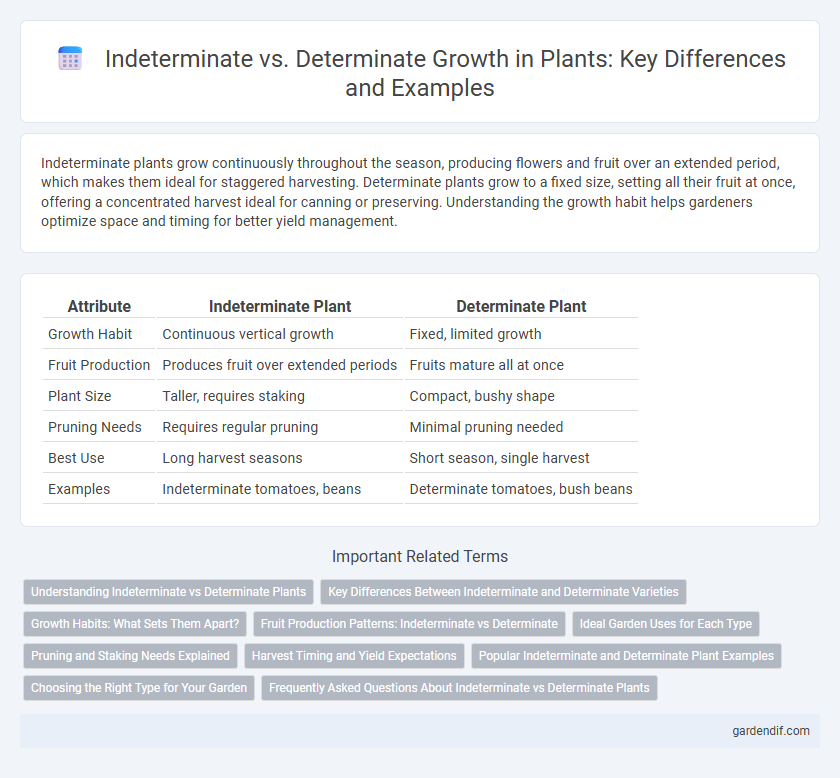
Indeterminate vs Determinate Illustration
Indeterminate plants grow continuously throughout the season, producing flowers and fruit over an extended period, which makes them ideal for staggered harvesting. Determinate plants grow to a fixed size, setting all their fruit at once, offering a concentrated harvest ideal for canning or preserving. Understanding the growth habit helps gardeners optimize space and timing for better yield management.
Table of Comparison
| Attribute | Indeterminate Plant | Determinate Plant |
|---|---|---|
| Growth Habit | Continuous vertical growth | Fixed, limited growth |
| Fruit Production | Produces fruit over extended periods | Fruits mature all at once |
| Plant Size | Taller, requires staking | Compact, bushy shape |
| Pruning Needs | Requires regular pruning | Minimal pruning needed |
| Best Use | Long harvest seasons | Short season, single harvest |
| Examples | Indeterminate tomatoes, beans | Determinate tomatoes, bush beans |
Understanding Indeterminate vs Determinate Plants
Indeterminate plants continue to grow and produce fruit throughout the growing season, often reaching substantial heights and requiring more space for support, making them ideal for extended harvests. Determinate plants grow to a fixed size, set fruit all at once, and then stop growing, which suits gardeners seeking a concentrated harvest period. Understanding these growth habits helps optimize planting strategies to maximize yield and manage garden space efficiently.
Key Differences Between Indeterminate and Determinate Varieties
Indeterminate plants continuously grow and produce flowers and fruit throughout the growing season, often reaching considerable heights and requiring staking or trellising. Determinate plants grow to a fixed mature size, produce a concentrated crop of fruit in a shorter timeframe, and generally don't require extensive support. These growth patterns affect harvest timing, plant care, and yield capacity, making selection crucial for garden design and crop planning.
Growth Habits: What Sets Them Apart?
Indeterminate plants exhibit continuous growth and flowering throughout the growing season, producing vines that can extend indefinitely under optimal conditions. Determinate plants have a predetermined growth limit, typically maturing all their flowers and fruit simultaneously, resulting in a more compact and bushier habit. This fundamental difference in growth habits influences pruning, harvesting schedules, and space requirements in garden planning.
Fruit Production Patterns: Indeterminate vs Determinate
Indeterminate plants produce fruit continuously over a longer period as new flowers develop above older ones, allowing for extended harvest times. Determinate plants generate fruit all at once because their flower clusters stop growing after reaching a certain size, resulting in a concentrated harvest. This difference in fruit production patterns affects yield scheduling and management in crops like tomatoes and beans.
Ideal Garden Uses for Each Type
Indeterminate tomato plants continue growing and producing fruit throughout the season, making them ideal for extended harvest periods in larger gardens or containers. Determinate plants grow to a fixed size, producing all their fruit in a shorter time span, which suits small gardens or spaces where a concentrated harvest is preferred. Gardeners seeking continuous fresh tomatoes should choose indeterminate varieties, while those aiming for ease of harvest and preservation generally favor determinate types.
Pruning and Staking Needs Explained
Indeterminate plants grow continuously and produce flowers and fruit throughout the season, requiring regular pruning to manage their size and support through staking to prevent sprawling. Determinate plants grow to a fixed size, typically needing minimal pruning and stakes mainly to support the weight of mature fruit clusters. Proper understanding of these growth habits ensures effective pruning strategies and staking techniques to optimize plant health and yield.
Harvest Timing and Yield Expectations
Indeterminate plants continuously grow and produce flowers and fruit throughout the growing season, leading to a prolonged harvest period and potentially higher cumulative yields. Determinate plants grow to a fixed size, setting all flower buds simultaneously, resulting in a concentrated harvest window ideal for single or early harvests but often with lower total yield over time. Understanding these growth habits helps optimize planting schedules and harvest planning for maximum productivity.
Popular Indeterminate and Determinate Plant Examples
Tomato plants are a popular example of indeterminate varieties, growing continuously and producing fruit throughout the season, while determinate tomato plants grow to a fixed size and produce fruit all at once. Other common indeterminate plants include cucumbers and pole beans, which exhibit climbing growth and extended harvest periods. Determinate plants such as bush beans and certain pepper varieties grow to a compact size and yield a concentrated harvest, making them ideal for container gardening and limited space.
Choosing the Right Type for Your Garden
Selecting between indeterminate and determinate plants hinges on garden space and harvest goals. Indeterminate varieties, such as many tomato types, produce fruit continuously throughout the growing season, ideal for long-term fresh yields in larger gardens. Determinate plants grow to a fixed size and produce a single, concentrated harvest, making them suitable for limited spaces and canning or preserving purposes.
Frequently Asked Questions About Indeterminate vs Determinate Plants
Indeterminate plants continue growing and producing fruit throughout the season, while determinate plants grow to a fixed size and yield all their fruit within a short period. Gardeners often ask which type is better for container gardening; indeterminate varieties usually require more space and support due to their sprawling growth. Choosing between indeterminate and determinate plants depends on desired harvest duration and available gardening space.
Indeterminate vs Determinate Infographic

 gardendif.com
gardendif.com